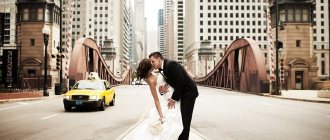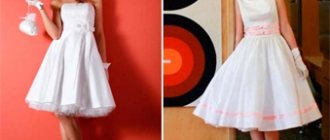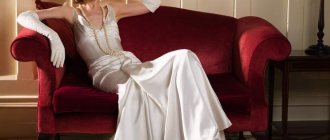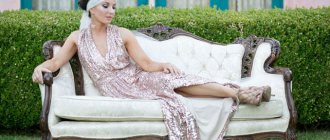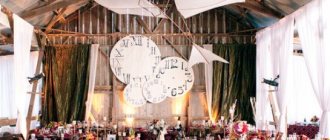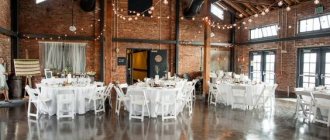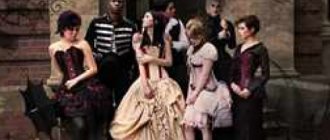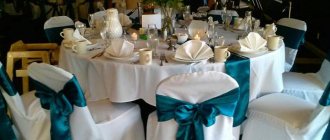Vintage style has always been considered one of the most advantageous. Fashion is constantly changing, but nevertheless it often returns to those old, but still relevant trends.
If you wear your grandma's wedding dress and add modern details, the bride won't look ridiculous. This is a retro look that is so popular and common today.
Every girl, at least for a moment, wants to feel like a film star of the 70s, a star of the 80s and a heroine of the 90s. All this can be done at a wedding by choosing the right dress and appropriate accessories.
Style Description
The fascinating and slightly mysterious retro style is extremely popular. Photos of models from fashion shows confirm that this style is interesting to most fashion designers. However, it is in wedding fashion that the retro style is especially in demand, since thanks to this trend, it is easiest to achieve a unique and memorable result.
What explains such a high popularity of the style? Firstly, of course, its diversity, because you can choose dresses from different eras. Secondly, it is this style that allows you to try on unusual images, that is, to feel like an actress, to embody a new, unexpected image.
Retro style is a special fashion trend that uses outfits from different eras. It is not necessary to completely reproduce clothing models “from the past”; sometimes designers use only individual elements that were fashionable in past decades to decorate a modern suit.
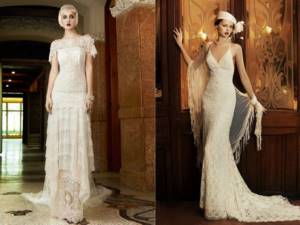
It is clear that only the best fashion details of the past are “borrowed”, so this style remains one of the most sophisticated and beautiful.
The name of the style is borrowed from the Latin language; in translation, the word “retro” means “movement back to the past.” This fashion trend covers a fairly large period of time. However, no clear time frame has been established. In most cases, all fashion trends of the past century are now considered retro style. However, you can delve into more ancient history, using fashionable elements of the second half of the nineteenth century to decorate a modern suit.
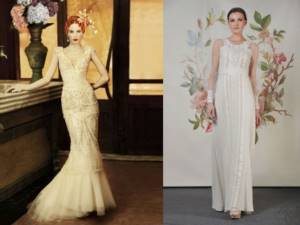
Things that are not stylized “to resemble the past”, but were actually produced in the period from the 30s to the 70s of the last century, are called vintage. Vintage is a style that “echoes” retro , however, it is based precisely on the use of old things, and not on stylization. However, these requirements are not strict, because not everyone has the opportunity to purchase real vintage jewelry and clothing.
Wedding scenario in disco style
Dancing, dancing and more dancing - this is the main component of the scenario for a disco wedding. The era of the 80s is rich in incendiary musical works that are loved to this day by everyone without exception.
Editor's choice: Wedding manager: assistant in organization and execution
Of course, you can’t do without fun competitions at a wedding. In addition to traditional ones, you also need to come up with themed entertainment:
- guess the artist by the title of the song;
- guess the composition by the melody;
- select all songs of a specific artist from the list;
- perform a popular hit best;
- answer quiz questions on your knowledge of films or TV series of that time and much more.
Time travel
Before choosing a wedding dress in a retro style, you need to decide on the era from which we will draw ideas. Each decade of the last century has its own characteristic features, but the most striking in terms of fashion were the third and sixth decades of the last century.
The rebellious twenties
One of the turning points in the history of fashion was the third decade of the twentieth century. The time after the end of the First World War was difficult. Most women needed to work to earn a living. Therefore, pre-war dresses with corsets and lush frills were sent into retirement, because they were completely impractical.
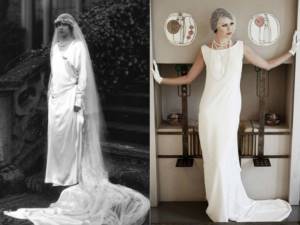
Despite the fact that the hardships of the war were left behind, women's worldview regarding clothing underwent such significant changes that this could not but affect fashion. Dresses of the 20s carefully “hide” feminine curves. After all, girls of that time gained independence and autonomy. They wanted to prove to the world that they were in no way inferior to men. However, women remain women at any time, so the outfits of that time were not only practical, but also beautiful.
Who suits 70s-90s fashion?
One famous couturier said about fashion this way: “What suits you is fashionable!”
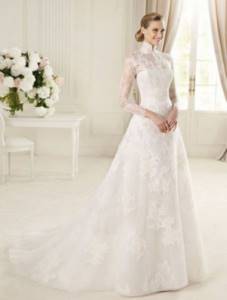
Wedding dresses of the 90s, photos.
Therefore, when going to the store for a wedding dress, you should first consider:
- Your desire.
- Features of the figure.
- Height.
- Color type.
Girls who have:
- Tall.
- A refined figure.
- Long hair.
70s wedding dresses are now popular boho and rustic styles. Their main feature is complete freedom and naturalness. The elongated style of the outfit will help embody the atmosphere of that time.
You should choose 80s fashion if you have:
- Lush breasts.
- Thin waist.
- Wide hips.
- Medium height.
Lush styles of dresses, as if from cartoons about princesses, appeared at this time. A slimming corset bodice and a skirt with multi-layered tulle are what characterize wedding times in the 80s.
The 90s were a time of experimentation in terms of fashion trends. Crinoline began to be used as the main material when sewing wedding dresses. A hat was considered a mandatory accessory in the image.
How to create a successful retro look?
In order for a retro wedding look to be truly successful and not look like an unsuccessful parody, several conditions must be met:
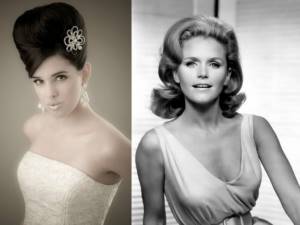
- Complete “immersion” in the era is necessary. It is advisable to look at fashion magazines of that time, paying attention not only to the cut of dresses, but also to the selection of accessories.
- In addition to clothes, you need to choose the right hairstyle, otherwise the image will not turn out complete.
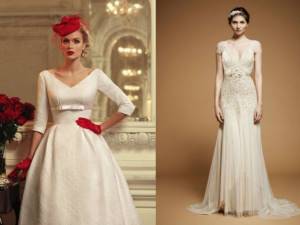
- When choosing a wedding dress, do not forget about the characteristics of your physique. For example, if your shoulders are already wide, then you should not choose models with shoulder pads that artificially widen the shoulder line.
Wedding table
Tables for guests can be placed in the shape of the letter “P”. This was the custom in those days. The place for the newlyweds is decorated with balloons, and bright dishes are used on the tables, glasses are beautifully arranged, souvenir piggy banks and other trinkets will decorate the table.
You don't even have to spend a lot. Parents and their friends probably have an abundance of such things
If you can get siphons for sparkling water, which were in short supply at that time, it would be absolutely amazing! Wedding cakes were distinguished by their colorfulness and floral arrangements, order such a treat.
Fabrics
To sew a retro dress, you should use satin, crepe, and silk. Airy translucent fabrics - organza, chiffon, tulle - are in demand. In almost all eras, lace was used as trim for wedding dresses. You can use lace fabric to sew the dress itself. For straight silhouette models, you need to choose fabrics that hold their shape well. In winter you can use velvet or brocade; in summer it is better to give preference to satin.
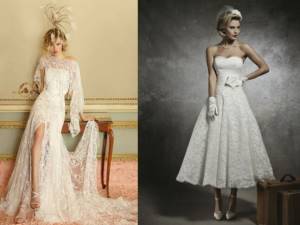
The color of retro style outfits does not have to be snow-white. Many brides prefer warm shades of white - ivory or champagne, cream, etc.
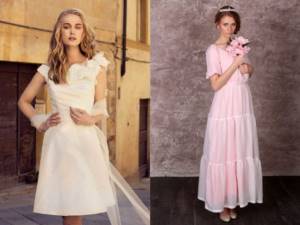
Some brides prefer dresses in pastel colors; soft pink, light lilac, and golden sand are especially popular. When choosing an outfit in the style of the fifties, you can give preference to printed fabrics. The most popular option is polka dot outfits. But materials with a checkered or floral pattern are often used.
Cut and design options
Existing versions of retro wedding dresses are the most successful stylizations of models of the last century, adapted to modern trends.
Sleeveless with bare back
This retro dress design is from the 20s and Gatsby style. The loose, sleeveless silhouette features a completely flat front that contrasts favorably with the deep cutout at the back.
Silk, chiffon, lace, and velvet are used for tailoring. For decoration - precious and artificial stones, pearls, beads, fringe.
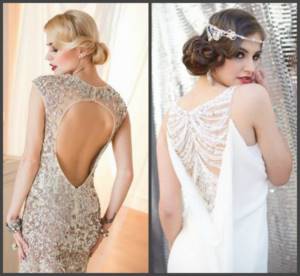
Train and cutout at back
Wedding dresses with long trains and low backs came in a retro style from the 30s. They were made of satin and silk.
A similar cut is also typical for vintage outfits - Greek and Victorian. In the first case, the naked back is decorated with draperies that smoothly turn into a train. In the second, the train “grows” out of the skirt, as it forms a single fabric with it.
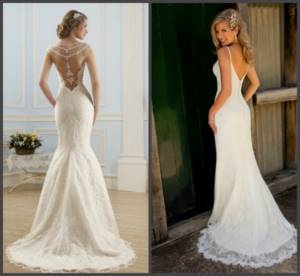
Full skirt and tight top
The A-silhouette is typical for dresses of the 50s and 60s. It is suitable for brides who want to emphasize a graceful waist and hide imperfections in the hips (excessively wide or, on the contrary, too narrow).
Retro wedding dresses of this type are made both from simple fabrics (the designers do not skimp on decor - lace, pearls, rhinestones) and from luxurious fabrics such as satin.
If you're looking for a classic, retro A-line dress for your wedding, opt for a long satin gown in a light shade with a full skirt for an elegant look.
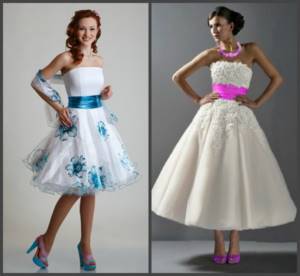
Deep neckline and corset
A retro wedding dress with a deep neckline and a lace-up corset is a reference to the design of the Victorian era, which lost chastity and gained boldness and sex appeal.
Many brides choose this particular design for a wedding dress to emphasize the waist with a corset, open up the neckline and make the silhouette graceful with a long and full skirt.

Decor and accessories
Accessories for a retro wedding look need to be selected especially carefully, taking into account the characteristics of the era from which the idea of the outfit was borrowed. So, for a twenties-style outfit, you need square-heeled shoes with a rounded toe and webbing at the ankle. A look in the style of the 50s or 60s requires stiletto heels.
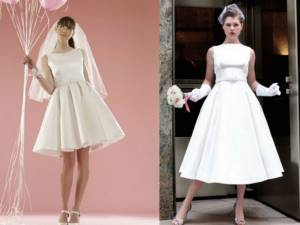
A veil will be appropriate with almost any wedding look, but the model of the veil must match the image. Short and laconic dresses require a single-layer short veil. For models with flounces and a train, you can choose a fluffy floor-length model.
Models in the style of the 20s and 30s will go well with long, hand-fitting gloves. If you choose a dress in the “new look” style, then you need openwork gloves that slightly cover the wrist. For a winter celebration, brides are recommended to prepare a fur muff or boa.
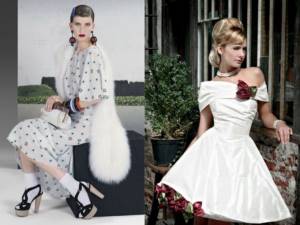
You need to choose your jewelry thoughtfully. If it is possible to wear real vintage items, then they should be a solo part of the ensemble; there is no need to “overshadow” them with modern jewelry. If you don’t have vintage jewelry, then you need to choose jewelry that matches your style. A large brooch or short necklaces made of large beads are ideal for a fifties-style look. For a jazz style look, you need to wear several long strings of beads.
Models – with photos
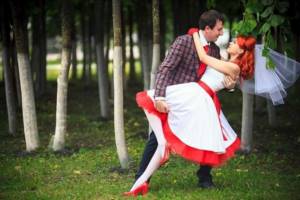
"The Great Gatsby"
While on one continent the kings of smuggled alcohol made a fortune from Prohibition, and on another continent they were recovering from the shocks of the world war, women all over the world gained the opportunity to become more relaxed: not only in their behavior, but also in the choice of chic outfits that were so lacking in the difficult wartime.
In the 20s, the years of dazzling glamor and brilliant jazz, fashion designers abandoned full skirts and confining corsets. Elegant dresses of a loose rectangular cut with a bold neckline, usually on the back, have come into fashion.
Interesting! Modern fashion for dresses of the 20s returned after the release of the film “The Great Gatsby” with the inimitable Leonardo DiCaprio.
Dresses with a rectangular silhouette perfectly hid figure flaws, be it a not too thin waist or a protruding tummy. The aristocracy and sophistication of the image helped to emphasize the neutral shades of noble fabrics: silk, velvet, lace, chiffon. Fringes, precious stones, embroidery, furs or feathers were chosen to decorate dresses.
The following accessories were used:
- pearl beads;
- neckpiece;
- gloves;
- feather boa;
- fur coat;
- a small bucket bag embroidered with stones or beads.
The hairstyle should be complemented by:
- silk scarf;
- mesh veil;
- miniature hat;
- bandages and forehead coverings decorated with pearls, rhinestones, stones and beads, feathers.
Today, brides are offered retro dresses with a rectangular silhouette and low waist in ivory, beige or cream. There should be no emphasis on the waist, and if you don’t want to open your back, then the neckline area should be covered with lace or chiffon. It is better to avoid sleeves. Length - just below the knee.

Chicago
The fashion of the 1930s was influenced by the economic crisis and the Great Depression. There was a catastrophic shortage of money, people were fired from factories that were closing everywhere, and therefore most women could not afford chic outfits.
The glamor of the Jazz Age was replaced by understated elegance. The dresses were quite long: ankle-length, and sometimes longer. Very short skirts were not encouraged.
Long dresses with slouchy hips, the style of which later became known as “Chicago,” were very popular. They were made from dense fabrics: satin, silk, velvet or chiffon. Generous drapery or flounces became a characteristic feature. Small hats, fur coats and long gloves were chosen as accessories.
In the 30s, the color of the dress could be any, but for a modern wedding it is better to choose white, ivory, soft pink or cream. This outfit will give your image strict elegance and grace.
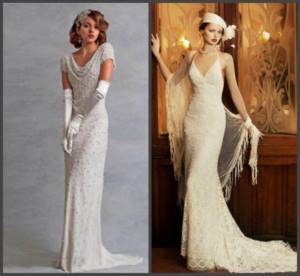
Military 40s
Wartime dictated the strictest economy of resources: the shortage of textiles, which was required for sewing uniforms, led to the fact that the skirts of women's dresses became shorter (to the knees) and narrower. The top of the dress, blouse or jacket seemed to be cut according to the patterns of a military tunic. It was in the 40s that wide square shoulders came into fashion.
To add elegance to the look, resourceful women used accessories - primarily a variety of hats.
Interesting! After the occupation of France, American designers and fashion designers became trendsetters.
Today, wedding dresses in the style of the 40s are a delicate texture of tulle and chiffon, bare shoulders or long sleeves.
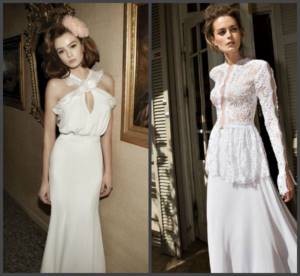
Luxurious 50s
Yearning for color and bold decisions during the years of war restrictions, designers returned bright dresses with a deep neckline and a fluffy short skirt to the catwalks in the 50s. Often, very bold and sexy outfits were worn by busty women with wide hips, because the fashion for thin young ladies with languid eyes had passed.
Preference was given to the hourglass silhouette, which had great advantages:
- the skirt widened at the bottom created the effect of a wasp waist;
- a knee-length or floor-length bell skirt hid wide hips;
- the knee-length made it possible to demonstrate the beauty of the legs;
- The deep neckline emphasized her ample breasts.
Today, wedding dresses in the “new look” style are a multi-layered full skirt, a wasp waist, a corset or open shoulders, and a small hat (or its imitation). If in the 50s the accents of makeup were scarlet lips and black wide eyeliner, then today's brides should choose this option only if they are absolutely sure that it is suitable.
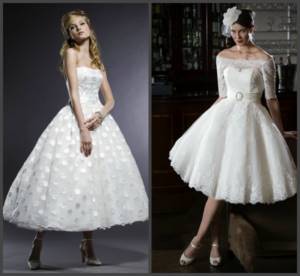
Hipsters
The sixties continued some of the trends of the previous decade and abandoned others. The skirts retained their layering, the belt still focused attention on the thin waist, but the neckline began to disappear (with the exception of the V-shaped neckline on the back).
The color scheme is absolutely free, but the brighter, the more fun it is to boogie-woogie. Geometric prints (especially chic - a skirt with large polka dots with a starched petticoat), bright jewelry, bow headbands on a fluffed up hairstyle, large eyelashes and a doll-like look - the image demanded extravagance, courage, and recklessness.
Today, brides can choose a white dress with a characteristic A-line silhouette and add retro notes to it with bright details : large beads, a high bouffant, a contrasting belt, a fluffy petticoat.
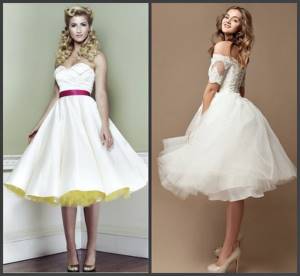
Hippie
Hippie style is a protest against the system, stereotypes and inequality. “Flowers of Life” advocated peace and love, chanting “Make love, not war!”, which literally means “Make love, not war!” The hippie worldview also influenced the formation of a style whose hallmarks were simple silhouettes, unpretentiousness, originality and ethnic motifs.
Hippie clothes are old jeans, without labels or brands, jackets and vests with embroidery or fringe made from natural fabrics.
Interesting! Hippie accessories - baubles, ribbons or thin braided hair cords.
It takes a lot of courage to wear a hippie dress to a wedding. The colors alone are worth it! They can be natural earth tones (brown, green, yellow) or acidic with various psychedelic patterns.
An important point for the hippie look is the hairstyle. For women, this is usually long, flowing hair, sometimes braided or tied into ponytails. Often hippies would braid a thin braid or several, leaving the rest of their hair loose and weaving threads, beads, beads or ribbons into the braids.
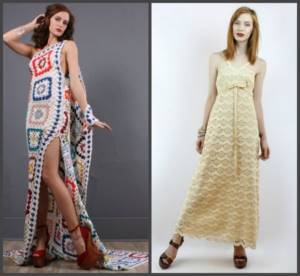
Hair and makeup
To achieve a complete look, you need to choose the right hairstyle and makeup. Hairstyles with waves go perfectly with a jazz style look. The ideal option would be a short haircut, but if your hair is long, then you should put it in a simple bun.
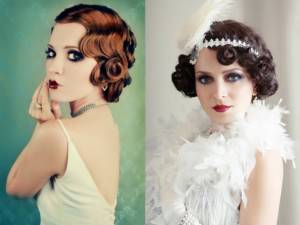
Hairstyles with curls and hair arranged in rollers above the forehead or above the temples are suitable for the look in the style of the 30s and 40s. If you are creating an image in the style of the fifties, then you will need to do a high hairstyle with a backcomb. If possible, you should use hairpieces or special extensions to add volume to your hair.
To do your makeup correctly, you should look at photos of beauties of that time. In any case, you need to take care of the ideal skin tone. To give your face more expressiveness, you should use bronzers. Set makeup with transparent loose powder.
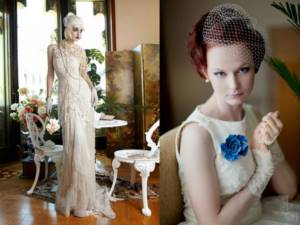
The emphasis is usually on the eyes. Long arrows and false eyelashes are welcome. To add some spice to your appearance, you can use a “fly” by sticking it above your lip.
So, a retro wedding look is a chance to emphasize your individuality and be unique on your wedding day.
Wedding cake
What's a wedding without a cake? A sweet dessert should be a worthy end to the holiday.
Traditionally, a disco wedding cake is a multi-tiered confection topped with a glittery disco ball.
Other decorative elements could be stars, silhouettes of dancing people, or portraits of Soviet stars.
The cake may not be decorated at all, but it is made in bright colors, symbolizing the tones of an iridescent disco ball.
Editor's Choice: Current and fashionable wedding styles of 2021


